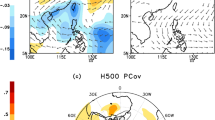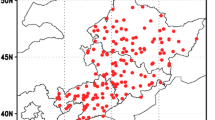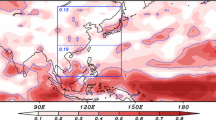Abstract
Improvement in the seasonal forecasting of East Asian summer monsoon rainfall (EASMR) remains a great challenge, as it is influenced by varied and complex impacts from (1) external forcings and slowly varying internal variabilities, which are potentially predictable, and (2) internal dynamics on intraseasonal time scales, which is basically unpredictable beyond a season. In this work, a (co-)variance decomposition method is applied to identify the leading potentially predictable (slow) patterns of the EASMR [the seasonal mean rainfall in the region (5°–50° N, 100°–140° E) in June–July–August] during 1979–2019 by separating the unpredictable noise (intraseasonal). We focus on the most critical predictable sources that are additional to the decaying (DC) El Niño–Southern Oscillation (ENSO), developing (DV) ENSO, and spring Arctic Oscillation (AO)—the three most important and well-recognized predictors for EASMR. We find that (1) the indices that represent the EASMR predictability related to the DC ENSO, spring AO and DV ENSO are the preceding November to March Niño1 + 2 sea surface temperature (SST), the April–May AO, and the May Niño4 SST, respectively; (2) the dominant additional predictable EASMR signals that are linearly independent of the DC ENSO, spring AO and DV ENSO have apparent relationships with the interannual variability of the SST in the western North Pacific, tropical and southern Atlantic, southern Indian, and Arctic oceans during boreal springtime, as well as the linear trend; and (3) by applying a principal component regression scheme to evaluate the EASMR predictability arising from DC/DV ENSO–AO and these additional predictors, the cross-validated fraction variance skill of the total seasonal mean EASMR is 11% (8%—land; 13%—ocean) for the former, and 15% (15%—land; 15%—ocean) for the latter, with a total of 26% that comprises more than 80% of the potential predictability of the EASMR. The considerable skill stemming from the predictors additional to DC/DV ENSO–AO indicates that they are worthy of attention in the seasonal forecasting of EASMR, especially for terrestrial areas.








Similar content being viewed by others
Code and data availability
R code supporting the computations of the interannual (co-)variance in the predictable and unpredictable components are provided in the supplementary information attached to this paper. The analysis presented in this paper is based on previously published datasets the availability of which is described in the Data and Methods Section (Sect. 2.1).
References
Adler RF, Huffman GJ, Chang A, Ferraro R, Xie PP, Janowiak J, Rudolf B, Schneider U, Curtis S, Bolvin D, Gruber A, Susskind J, Arkin P, Nelkin E (2003) The version-2 Global Precipitation Climatology Project (GPCP) monthly precipitation analysis (1979–present). J Hydrometeor 4:1147–1167
Barnston AG, Livezey RE (1987) Classification, seasonality and persistence of low-frequency atmospheric circulation patterns. Mon Weather Rev 115:1083–1126
Chen M, Xie P, Janowiak JE, Arkin PA (2002) Global land precipitation: a 50-yr monthly analysis based on gauge observations. J Hydrometeor 3:249–266
Ding Y, Chan JCL (2005) The East Asian summer monsoon: an overview. Meteorol Atmos Phys 89:117–142
Fan K, Liu Y, Chen H (2012) Improving the prediction of the East Asian summer monsoon: new approaches. Wea Forecast 27:1017–1030
Frederiksen CS, Zheng X (2004) Variability of seasonal-mean fields arising from intraseasonal variability: Part2, application to NH winter circulations. Clim Dyn 23:193–206
Frederiksen CS, Zheng X (2007) Variability of seasonal-mean fields arising from intraseasonal variability: Part3, application to SH winter and summer circulations. Clim Dyn 28:849–866
Frederiksen CS, Zheng X, Grainger S (2014) Teleconnections and predictive characteristics of Australian seasonal rainfall. Clim Dyn 43:1381–1408
Grainger S, Frederiksen CS, Zheng X (2017) Projections of Southern Hemisphere atmospheric circulation interannual variability. Clim Dyn 48:1187–1211
Guan Z, Yamagata T (2003) The unusual summer of 1994 in East Asia: IOD teleconnections. Geophys Res Lett 30:1544
Guo D, Gao Y, Bethke I, Gong D, Johannessen OM, Wang H (2014) Mechanism on how the spring Arctic sea ice impacts the East Asian summer monsoon. Theor Appl Climatol 115:107–119
He S, Gao Y, Li F, Wang H, He Y (2017) Impact of Arctic Oscillation on the East Asian climate: a review. Earth Sci Rev 164:48–62
Higgins RW, Leetmaa A, Kousky VE (2002) Relationships between climate variability and winter temperature extremes in the United States. J Clim 15:1555–1572
Jin D, Huo L (2018) Influence of tropical Atlantic sea surface temperature anomalies on the East Asian summer monsoon. Q J R Meteorol Soc 144:1490–1500
Johnson NC (2013) How many ENSO flavors can we distinguish? J Clim 26:4816–4827
Kalnay E, Kanamitsu M, Kistler R, Collins W, Deaven D, Gandin L, Iredell M, Saha S, White G, Woollen J, Zhu Y, Leetmaa A, Reynolds R, Chelliah M, Ebisuzaki W, Higgins W, Janowiak J, Mo KC, Ropelewski C, Wang J, Jenne R, Joseph D (1996) The NCEP/NCAR 40-year reanalysis project. Bull Am Meteorol Soc 77:431–471
Lee DY, Ahn JB, Yoo JH (2015) Enhancement of seasonal prediction of East Asian summer rainfall related to western tropical Pacific convection. Clim Dyn 45:1025–1042
Li J, Wang J (2003) A new North Atlantic Oscillation index and its variability. Adv Atmos Sci 20:661–676
Li J, Zeng Q (2002) A unified monsoon index. Geophys Res Lett 29:1274
Li S, Lu J, Huang G, Hu K (2008) Tropical Indian Ocean basin warming and East Asian summer monsoon: a multiple AGCM study. J Clim 21:6080–6088
Li C, Lu R, Dunstone N, Scaife A, Bett P, Zheng F (2021) The seasonal prediction of the exceptional Yangtze River rainfall in summer 2020. Adv Atmos Sci 38:2055–2066
Liu YY, Ke ZJ, Ding YH (2019) Predictability of East Asian summer monsoon in seasonal climate forecast models. Int J Climatol 39:5688–5701
Madden RA (1976) Estimates of the natural variability of time averaged sea level pressure. Mon Weather Rev 104:942–952
Park CK, Schubert SD (1997) On the nature of the 1994 East Asian summer drought. J Clim 10:1056–1070
Rayner NA, Parker DE, Folland CK, Alexander LV, Horton EB, Rowell DP (2003) Globally complete analyses of sea-surface temperature, sea-ice and marine air temperature, 1871–2000. J Geophys Res 108:4407
Rong X, Zhang R, Li T (2010) Impacts of Atlantic sea surface temperature anomalies on Indo-East Asian summer monsoon–ENSO relationship. Chin Sci Bull 55:2458–2468
Shukla J (1983) Comment on “Natural variability and predictability.” Mon Weather Rev 40:581–585
Takaya YH, Kosaka Y, Watanabe M, Maeda SH (2021) Skillful predictions of the Asian summer monsoon one year ahead. Nat Commun 12:2094
Trenberth KE (1997) The definition of El Niño. Bull Am Meteorol Soc 78:2771–2777
Wang B, Fan Z (1999) Choice of South Asian summer monsoon indices. Bull Am Meteorol Soc 80:629–638
Wang B, Lin H (2002) Rainy season of the Asian-Pacific summer monsoon. J Clim 15:386–396
Wang B, Wu R, Fu X (2000) Pacific-East Asian teleconnection: how does ENSO affect East Asian climate? J Clim 13:1517–1536
Wang B, Lee JY, Kang IS, Shukla J, Kug JS, Kumar A, Schemm J, Luo J, Yamagata T, Park C (2008a) How accurately do coupled climate models predict the leading modes of Asian-Australian monsoon interannual variability? Clim Dyn 30:605–619
Wang B, Li J, Liu J, Chang CP, Ding Y, Wu G (2008b) How to measure the strength of the East Asian summer monsoon. J Clim 21:4449–4463
Wang B, Xiang B, Lee JY (2013) Subtropical high predictability establishes a promising way for monsoon and tropical storm predictions. Proc Natl Acad Sci 110:2718–2722
Wang B, Lee JY, Xiang B (2015) Asian summer monsoon rainfall predictability: a predictable mode analysis. Clim Dyn 44:61–74
Wang C, Deser C, Yu JY, DiNezio P, Clement A (2016) El Niño and Southern Oscillation (ENSO): a review. In: Glymn P, Manzello D, Enochs I (eds) Coral reefs of the eastern Pacific. Springer, Berlin, pp 85–106
Wilks DS (1995) Statistical methods in the atmospheric sciences. Academic, Cambridge, p 467
Wu Z, Yu L (2016) Seasonal prediction of the East Asian summer monsoon with a partial-least square model. Clim Dyn 46:3067–3078
Wu B, Zhang R, Wang B, D’Arrigo R (2009a) On the association between spring Arctic sea ice concentration and Chinese summer rainfall. Geophys Res Lett 36:L09501
Wu Z, Wang B, Li J, Jin FF (2009b) An empirical seasonal prediction of the East Asian summer monsoon using ENSO and NAO. J Geophys Res 114:D18120
Xiao Z, Duan A (2016) Impacts of Tibetan Plateau snow cover on the interannual variability of the East Asian summer monsoon. J Clim 29:8495–8514
Xie P, Arkin PA (1997) Global precipitation: a 17-year monthly analysis based on gauge observations, satellite estimates, and numerical model outputs. Bull Am Meteorol Soc 78:2539–2558
Xie SP, Hu K, Hafner J, Tokinaga H, Du Y, Huang G, Sampe T (2009) Indian Ocean capacitor effect on Indo–western Pacific climate during the summer following El Niño. J Clim 22:730–747
Xing W, Wang B, Yim SY (2016) Peak-summer East Asian rainfall predictability and prediction part I: Southeast Asia. Clim Dyn 47:1–13
Yang S, Zhang Z, Kousky VE, Higgins RW, Yoo SH, Liang J, Fan Y (2008) Simulations and seasonal prediction of the Asian summer monsoon in the NCEP climate forecast system. J Clim 21:3755–3775
Yim SY, Jhnu JG, Lu R, Wang B (2010) Two distinct patterns of spring Eurasian snow cover anomaly and their impacts on the East Asian summer monsoon. J Geophys Res 115:D22113
Yim SY, Wang B, Xing W (2016) Peak-summer East Asian rainfall predictability and prediction part II: extratropical East Asia. Clim Dyn 47:15–30
Ying K, Zheng X, Zhao T, Frederiksen CS, Quan X-W (2017) Identifying the predictable and unpredictable patterns of spring-to-autumn precipitation over eastern China. Clim Dyn 48:3183–3206
Ying K, Frederiksen CS, Zhao T, Zheng X, Xiong Z, Yi X, Li C (2018) Predictable and unpredictable modes of seasonal mean precipitation over Northeast China. Clim Dyn 50:3081–3095
Zhang W, Huang Z, Jiang F, Stuecker MF, Chen G, Jin FF (2021) Exceptionally persistent Madden–Julian Oscillation activity contributes to the extreme 2020 East Asian summer monsoon rainfall. Geophys Res Lett 48:e2020GL091588
Zheng X, Frederiksen CS (2004) Variability of seasonal-mean fields arising from intraseasonal variability: Part 1. Methodology. Clim Dyn 23:171–191
Zheng X, Frederiksen CS (2006) A study of predictable patterns for seasonal forecasting of New Zealand rainfall. J Clim 19:3320–3333
Zheng X, Frederiksen CS (2007) Statistical prediction of seasonal mean southern hemisphere 500-hPa geopotenial heights. J Cim 20:2719–2809
Zheng X, Sugi M, Frederiksen CS (2004) Interannual variability and predictability in an ensemble of climate simulation with the JMA AGCM. J Meteorol Soc Jpn 82:1–18
Zheng X, Straus DM, Frederiksen CS (2008) Variance decomposition approach to the prediction of the seasonal mean circulation: Comparison with dynamical ensemble prediction using NCEP’s CFS. Q J R Meteorol Soc 134:1997–2009
Zheng F, Li J, Li Y, Zhao S (2016) Influence of the summer NAO on the spring-NAO-based predictability of the East Asian summer monsoon. J Appl Meteorol Clim 55:1459–1476
Zhou ZQ, Xie SP, Zhang R (2021) Historic Yangtze flooding of 2020 tied to extreme Indian Ocean conditions. Proc Natl Acad Sci 118:e2022255118
Acknowledgements
We gratefully acknowledge the two anonymous reviewers for their constructive comments, which helped greatly in improving the quality of this manuscript.
Funding
This work was supported by the National Natural Science Foundation of China (41991284), the National Key R&D Program of China (2020YFA0608904) and the National Natural Science Foundation of China (42141017).
Author information
Authors and Affiliations
Corresponding author
Ethics declarations
Conflict of interest
The authors declare that they have no conflict of interest.
Additional information
Publisher's Note
Springer Nature remains neutral with regard to jurisdictional claims in published maps and institutional affiliations.
Electronic supplementary material
Below is the link to the electronic supplementary material.
Appendix
Appendix
The steps in deriving the slow or predictable EOF patterns are:
-
1.
Derive the eigenvalues and eigenmodes of the total covariance matrix of the seasonal mean rainfall using an EOF analysis.
-
2.
Project the monthly rainfall anomalies onto the obtained leading Y − 1 (Y is the total number of years) eigenmodes (EOF modes) to form the Y − 1 truncated monthly PC time series.
-
3.
Estimate the (Y − 1) × (Y − 1) covariance matrix of the intraseasonal component for each pair of the Y − 1 truncated monthly PC time series using Eq. (3.1).
-
4.
The symmetric matrix from (3), above, is then pre-multiplied by the matrix of the leading Y − 1 EOF modes and post-multiplied by its transpose to form the full, or raw, intraseasonal covariance matrix.
-
5.
If the rth diagonal element of the raw intraseasonal covariance matrix is greater than its corresponding total variance, then the rth row and the rth column of the raw intraseasonal covariance matrix are replaced by rth row and the rth column of the total covariance matrix. This adjusted covariance matrix is the estimated intraseasonal covariance matrix.
-
6.
The slow covariance matrix is the difference between the total covariance matrix and the estimated intraseasonal covariance matrix.
-
7.
An EOF analysis is then applied to the slow covariance matrix to obtain the corresponding patterns.
Rights and permissions
Springer Nature or its licensor holds exclusive rights to this article under a publishing agreement with the author(s) or other rightsholder(s); author self-archiving of the accepted manuscript version of this article is solely governed by the terms of such publishing agreement and applicable law.
About this article
Cite this article
Ying, K., Jiang, D., Zheng, X. et al. Seasonal predictable source of the East Asian summer monsoon rainfall in addition to the ENSO–AO. Clim Dyn 60, 2459–2480 (2023). https://doi.org/10.1007/s00382-022-06461-4
Received:
Accepted:
Published:
Issue Date:
DOI: https://doi.org/10.1007/s00382-022-06461-4




